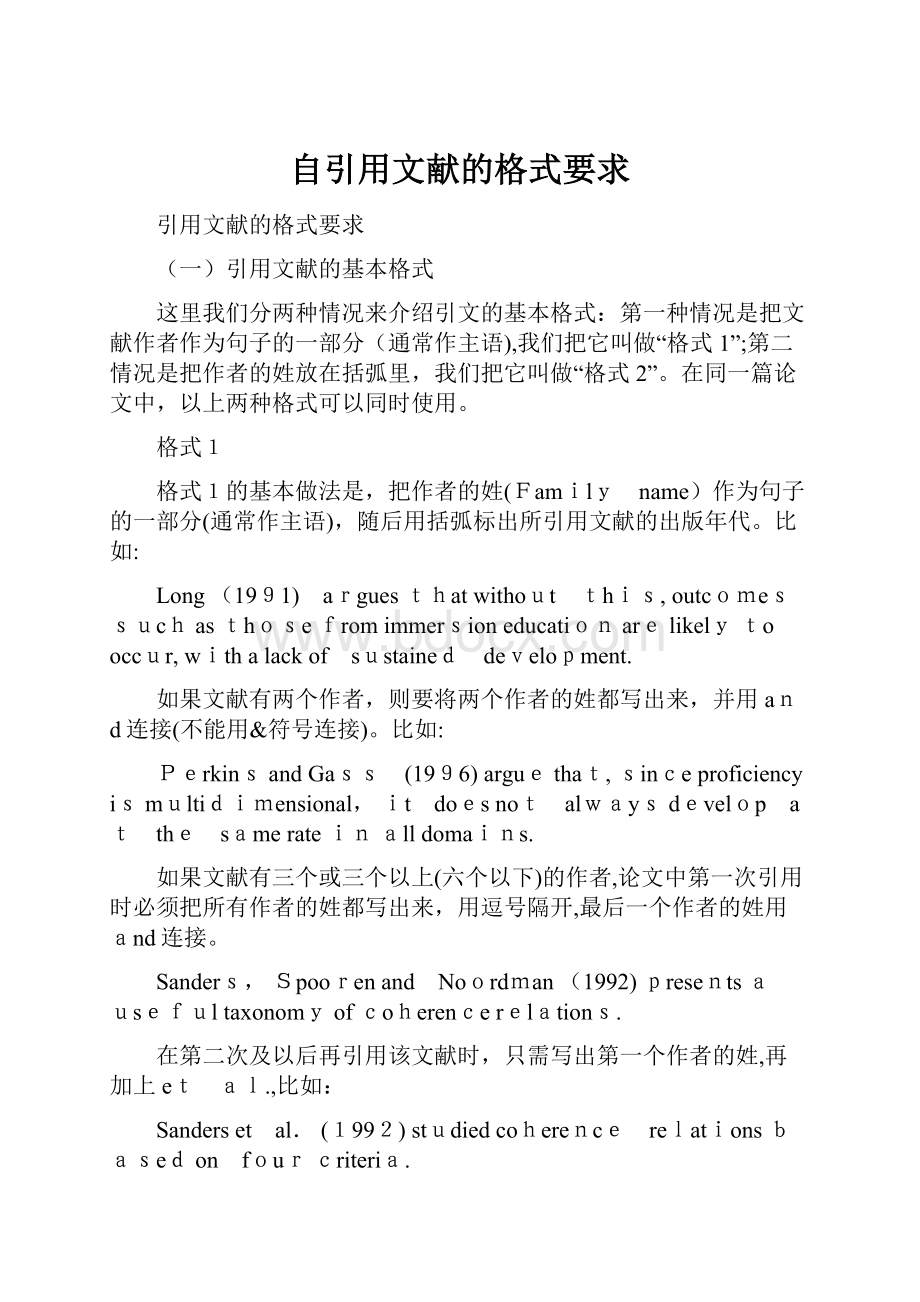自引用文献的格式要求.docx
《自引用文献的格式要求.docx》由会员分享,可在线阅读,更多相关《自引用文献的格式要求.docx(17页珍藏版)》请在冰豆网上搜索。

自引用文献的格式要求
引用文献的格式要求
(一)引用文献的基本格式
这里我们分两种情况来介绍引文的基本格式:
第一种情况是把文献作者作为句子的一部分(通常作主语),我们把它叫做“格式1”;第二情况是把作者的姓放在括弧里,我们把它叫做“格式2”。
在同一篇论文中,以上两种格式可以同时使用。
格式1
格式1的基本做法是,把作者的姓(Family name)作为句子的一部分(通常作主语),随后用括弧标出所引用文献的出版年代。
比如:
Long(1991) arguesthatwithout this,outcomessuchasthosefromimmersioneducationarelikelytooccur,withalackof sustained development.
如果文献有两个作者,则要将两个作者的姓都写出来,并用and连接(不能用&符号连接)。
比如:
PerkinsandGass (1996)arguethat,sinceproficiencyismultidimensional,it doesnot alwaysdevelop at the samerateinalldomains.
如果文献有三个或三个以上(六个以下)的作者,论文中第一次引用时必须把所有作者的姓都写出来,用逗号隔开,最后一个作者的姓用and连接。
Sanders,Spoorenand Noordman(1992)presentsa usefultaxonomyofcoherencerelations.
在第二次及以后再引用该文献时,只需写出第一个作者的姓,再加上et al.,比如:
Sanderset al.(1992)studiedcoherence relationsbasedon fourcriteria.
如果文献有六个或六个以上的作者,论文中第一次引用时只需写出第一个作者的姓,再加上etal.和年代。
使用格式1时,如有必要(如直接引用整句或句子的一部分),可以在年代后面再加上所文献的具体页码。
出版年代与页码之间用冒号隔开。
比如:
Messick(1989:
20) presentswhathe callsa‘progressivematrix’.
另外,页码也可以放在所引用文献的末尾,比如:
Gould(1989)explainsthatDarwinusedthemetaphor ofthe tree oflife“toexpress theother form ofinterconnectedness – genealogicalrather thanecological– andtoillustrateboth successandfailureinthe historyoflife”(p. 14).
如果所引用的内容在原文献中跨页(直接引用时一般应该只跨两页),则要标出页码范围,比如:
Hu(1994:
5~6) pointsoutthattext studiesinthe1960sandearly1970saremoreor less concerned with“textgrammar” and textual“grammaticality”.
或
Hu(1994)pointsout thattextstudiesinthe1960sandearly 1970saremore orless concerned with“text grammar” andtextual“grammaticality” (pp.5~6).
使用格式1中时,页码还可以用另外一种方法标出,即在年代之后不用冒号而用逗号,然后用p.(所引文献跨页时用pp.),再加页码,比如:
Messick (1989,p. 20)presents whathecallsa‘progressivematrix’.
Hu(1994,pp. 5~6) points outthat text studiesinthe1960sandearly1970s aremore orlessconcerned with“textgrammar” andtextual“grammaticality”.
注意,在同一篇论文中格式要统一。
要么都采用冒号加页码的格式,要么都使用p./pp.的格式,不能交替使用。
在直接引用文献时,如所引用的内容较长(一般超过50单词),则应该另起一段,左右缩进。
比如:
Lorenz(1999) voicedaverysimilarviewthatbecauseinwrittencommunication, coherence cannotbeexplicitlynegotiatedface-to-facebetween text producerand textreceiver,
“writerstherefore haveeveryreason fortryingto beunequivocaland tomake theirideas,intentions andarguments unmistakablyclear.Onewayofdoingthisistocarefullysignallogicalrelations and thereby‘signpost’ thepathtocoherenceforthereader.Consequently,whenlooking atthefabricationofcoherencein written discourse,we needtopay special attentionto those explicit signposts ofcoherence,i.e.thetext’scohesiveties”(p.55).
格式2
格式2的基本做法是,把作者的姓、出版年代以及页码均放在括弧里,出版年代紧随作者的姓,之后是页码。
比如:
Thisapproach tendsto assumeanautomatisationor practiceview oflearning(Bruton2002).
Thefirstcriticism isthat thetext-basedresearcherschoose tostudythe textitselffor“methodologicalconvenience” (Givón 1995:
59).
使用格式2时,作者的姓与出版年代之间也可以用逗号隔开,比如
Thisapproachtendstoassumean automatisationor practiceviewof learning (Bruton, 2002).
Thefirstcriticismisthatthetext-basedresearcherschoosetostudythetextitselffor“methodologicalconvenience” (Givón,1995:
59).
注意,在同一篇论文中,格式要统一,如果姓与年代之间用逗号,则都要用,不能有时用,有时不用。
使用格式2时,如果文献有两位作者,则必须把两位作者的姓都写出来,用&连接(不能用and),比如:
Duringthe1970stherewereconsiderable moveswithinlanguageteaching toembracethecommunicativeapproach(Brumfit &Johnson1979).
Onevalidatesnota test,but‘aprincipleformaking inferences’(Cronbach&Meehl,1955:
297).
(二)转引的格式
所谓转引,是指论文作者并没有看到某个文献的原始出版物,而是在另外一个文献中看到的。
比如Chapelle在其1998年的某个文献中引用了Shepard在1993年发表的文章中的内容。
现在论文作者看到的是Chapelle的文献,而不是Shepard的原始文献。
如果论文作者希望引用Shepard的话,则应该用下面的格式:
Ifconstructvalidityisseenasan exhaustiveprocess thatcan beaccomplishedover a50-year period,testdevelopersmay beinclinedtothink that anyvalidity informationisgood enoughintheshort run(Shepard1993:
444,citedinChapelle 1998).
上例中的citedin表示“转引自”。
注意,学位论文中不能有过多的转引的内容(参见有关文献综述的要求)。
(三)如何引用论文集的文献
论文集是指各章节由不同作者撰写并由一位或几位作者编辑出版的著作。
负责编辑出版的作者称为editor(s),封面和扉页一般会注明editedby,或在编辑者后面用括弧注明(Editor(s))。
在论文集中,前言(Preface)、导论(Introduction)及每篇文章(或每章)都单独署名。
引用论文集的内容时,要根据文献作者进行引用,不能用编辑者的姓名进行引用。
比如,M.A.Gernsbacher和T.Givón在1995年编辑出版了一本名为CoherenceinSpontaneous Text的论文集。
其中有A.Sanford和L.Moxey写的一篇文章Aspectsof coherenceinwrittenlanguage:
apsychological perspective。
如果要引用这篇文章的内容,则应该按以下格式:
Obviously Reinhart’scriterionof relevanceis infactobviously psychological, since“relevancecanonlybe definedwith respecttobackgroundknowledge, andreasoning processes”(Sanford &Moxey1995:
163).
在这种情况下,论文后面的参考文献的写法是:
Sanford, A.&Moxey,L.1995.Aspectsofcoherencein written language:
apsychological perspective. InGernsbacher,M.A.& Givon,T. (Eds.),CoherenceinSpontaneousText.pp.161-187.Amsterdam/Philadelphia:
JohnBenjaminsPublishingCompany.
(四)如何引用中文文献
在用英文撰写论文的过程中,如果要引用中文文献,要将引用的中文部分、作者以及出版物的信息翻译成英文,然后按英文论文的引文格式引用。
比如:
Forexample,textstudiesin the 1960sand early1970swere moreor lessconcerned with“textgrammar” and textual“grammaticality”(Hu,1994:
5~6).
Thesescholarschosetostudycoherenceasa socialphenomenon,ratherthanamentalphenomenon(Zhu& Yan,2001).
与以上两例对应的参考书目为:
Hu, Z.1994. Discourse Cohesionand Coherence(In Chinese).Shanghai:
ShanghaiForeignLanguageEducationPress.(胡壮麟,《语篇的衔接与连贯》,上海外语教育出版社。
)
Zhu,Y.&Yan,S.2001.Reflections on Systemic-FunctionalLinguistics(In Chinese).Shanghai:
ShanghaiForeign LanguageEducationPress.(朱永生, 严世清,《系统功能语言学多维思考》,上海外语教育出版社)。
注意,在英文论文中引用中文文献时不能写作者的全名(如HuZhuanglin,1994),也不能直接用中文(如胡壮麟,1994或胡,1994)。
在参考书目中,首先提供英文信息,并在文献名称后面加上(InChinese),表示该文献是用中文写的。
一般的学术期刊都会提供期刊名称及文献题目的英文翻译,作者不要自己随便翻译。
也有一种用汉语拼音来转写文献名称的做法,但这一做法并不流行。
(五)关于引文的其他注意事项
1.关于重复引用。
在同一段落中,连续两次或两次以上引用同一文献时(中间没有引用其他的文献),从第二次开始,不重复文献作者的姓和出版年代,而是用ibid.代替。
如所引内容在不同页码,可以在ibid.之后加上页码。
比如:
Aprincipleoftext sequencingisthat“withoutovertindications tothecontrary,theorder ofmentionofcertainitemsmay beassumedtoreflect theorderof these itemsin realityorin ourconceptualizationof reality”(Dik,1997:
435).This equals tosaythattextual descriptionofeventsor states-of-affairsshouldfolloweitherthe orderwhich actuallyexistsin theworlds describedortheorder inwhich weperceivetheworlds. AsDik(ibid.:
436)further pointsout,“as long astheorderingwithin thediscourseisinaccordancewiththese natural defaults, thisaddstothe overallcoherence.Wheresuchordersareshifted around,overtmarkers must warntheinterpreterof this marked situation”.
2.有时论文中不是直接或间接引用文献,而只是为了描述或介绍研究现状而提及某些文献,往往同时提及多种文献。
在这种情况下可以采用如下格式(注意使用e.g.,):
The situation withaccuracyisnotsoclear. Somestudies(e.g.,Foster&Skehan1996;Skehan&Foster1997;Mehnert1998) dosuggestthat accuracyisraisedwhen there is planning,butotherstudies(e.g.,Crookes1989;Ortega1999;Wigglesworth1997,2001) donotsupport this claim.
在这种情况下,可以用两种方法来安排文献的顺序。
一是按文献的年代排列,较早的排在前面(如上例);二是按作者的姓氏的字母顺序排列。
3.在同一处提及一个作者不同年代的文献时,可在括弧中列出若干个年代,用逗号隔开,按时间顺序排列。
比如:
AccordingtoHalliday(1973,1978,1985,1994),languagehasthree mainmetafunctions,namely,ideational metafunction,interpersonalmetafunction andtextualmetafunction.
4.如果需要同时引用某个作者在其独立完成的某个著作中的观点以及这个作者与其他作者合作的著作中的观点,可以采用下列两种格式:
However,McNamara (1995;McNamara &Lumley, 1997)haschallengedtheBachmanmodel.
However,researchers have challengedtheBachmanmodel (McNamara, 1995;McNamara &Lumley,1997).
5.在同一篇论文中如果需要引用同一作者在同一年出版的两种或两种以上的文献,则在年代后面用a, b,c等进行区分。
比如:
Hedrawsupa possibleresearch agenda thatwouldflowfrom the inclusionofasocialperspective– andin-deedsuch aresearchagendahas already bornefruitinseveralstudiesofthenature of theinteractionin oraltests (Porter1991a,1991b).
在参考书目中按下列格式列出对应的条目:
Porter,D.1991a.Affectivefactorsinlanguagetesting. InAlderson,J.C.&North,B.(Eds.), Language testinginthe 1990s:
the communicativelegacy(pp.32–40). London:
Macmillan (ModernEnglishPublicationsinassociationwiththeBritishCouncil).
Porter,D.1991b.Affective factorsin theassessmentoforalinteraction:
genderandstatus. InAnivan,S. (Ed.), Current developmentsinlanguagetesting(Vol. 25,pp.92–102).Singapore:
SEAMEORegionalLanguageCentre.AnthologySeries.
6.在同一论文中如果需要引用的两个作者的姓氏相同(即使出版年代不同),则需要加上作者的名字(Firstname)的首字母加以区分。
比如:
R. Dawkins (1986)andM. S.Dawkins(1980)havecontributedtoanunderstandingofconsciousnessinanimals.
7.如果所引用的文献没有具体的作者,而是某个机构出版物,在引用时用机构的名称代替作者的姓,比如:
Retired officersretainaccesstoalloftheuniversity’s educationalandrecreational facilities (Columbia University1995:
54).
8.词典或百科全书一般用出版物的名称,如果有大家熟悉的缩写形式,也可以使用缩写形式。
三、参考书目的基本格式
(一)专著的基本格式
只一位作者的文献:
作者姓+逗号+空格+作者名的首字母+点+空格+出版年代+点+空格+专著名称(斜体)+点+空格+出版地点+冒号+空格+出版公司+点。
比如:
Connor,U. 1996. Contrastive Rhetoric:
Cross-culturalAspectsof SecondLanguageWriting.NewYork:
CambridgeUniversityPress.
注意,专著的书名一定要用斜体(手写论文或用旧式打字机时在书名下加下划线),书名的每个单词(冠词和介词除外,除非在句首)都要大写。
一般地,书名中的副标题不需要全部大写,只将第一个单词的首字母大写。
两位作者的文献:
第一作者姓+逗号+空格+第一作者名的首字母+点+空格+&+第二作者的姓+逗号+空格+第二作者名的首字母+点+空格+出版年代+点+空格+专著名称(斜体)+点+空格+出版地点+冒号+空格+出版公司+点。
比如:
Brown,G.&Yule,G.1983.DiscourseAnalysis.Cambridge:
CambridgeUniversityPress.
三位作者以上的文献参照两位作者的文献的格式。
比如:
Butt,D.,Fahey,R.,Spinks,S., &Yallop,C.1995.UsingFunctionalGrammar:
An Explorer’sGuide.MacquarieUniversity:
NationalCentrefor EnglishLanguageTeachingandResearch.
注意,参考书目的条目中不允许使用etal.来代替其他作者。
应列出文献的所有作者的信息。
(二)学术期刊的文章
学术期刊的格式与专著基本相同,依次提供以下信息:
作者、出版年代、文章名称(正体,文章名的第一个单词的首字母大写,其余均为小写)、期刊名称(斜体,每个单词的首字母大写)、卷号(每年的若干期为一卷)、期号、文献起始页码。
比如:
Bateman,J.A.& Rondhuis,K. J.1997.Coherencerelations:
Towardsageneral specification.Discourse Processes,24(1),pp.3-49.
注意,如果所引用期刊的整卷统一编排页码(即一卷中的若干期连续编排页码),那么在参考文献中不需要提供期号(issuenumber),只需提供卷号(volumenumber)和页码。
如果每一期单独编排页码(即每期从第1页开始),那么则需要提供期号,如上例。
(三)论文集
论文集全书:
格式与专著基本相同,只是在编者后面要加上(Ed.)或(Eds.)如果只有一个编者,用Ed.;如果有两个或两个以上的编者,则用Ed